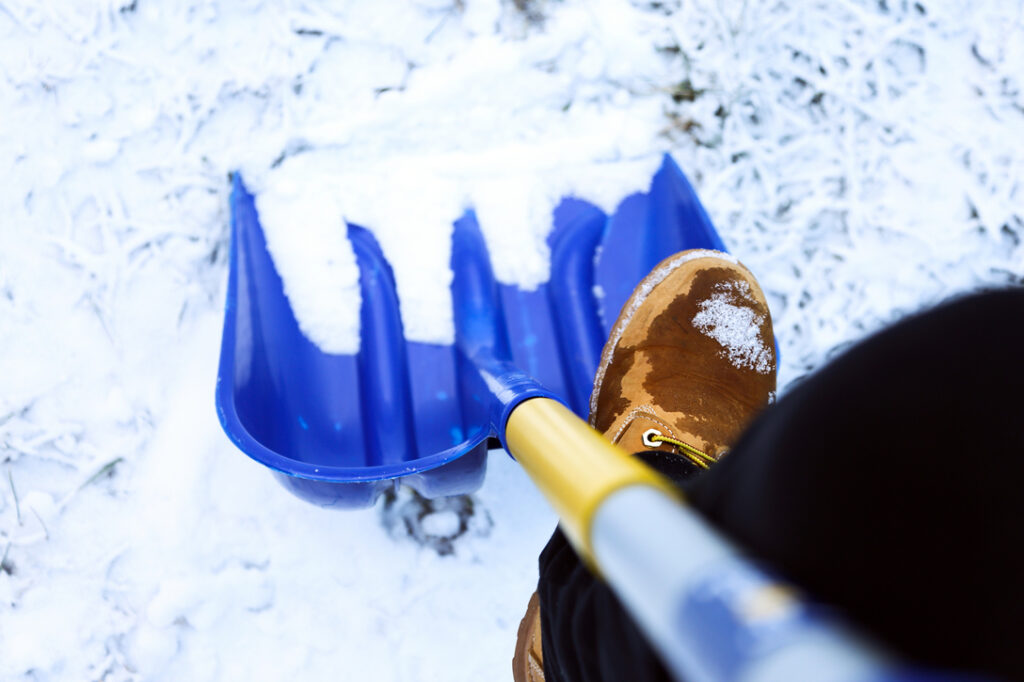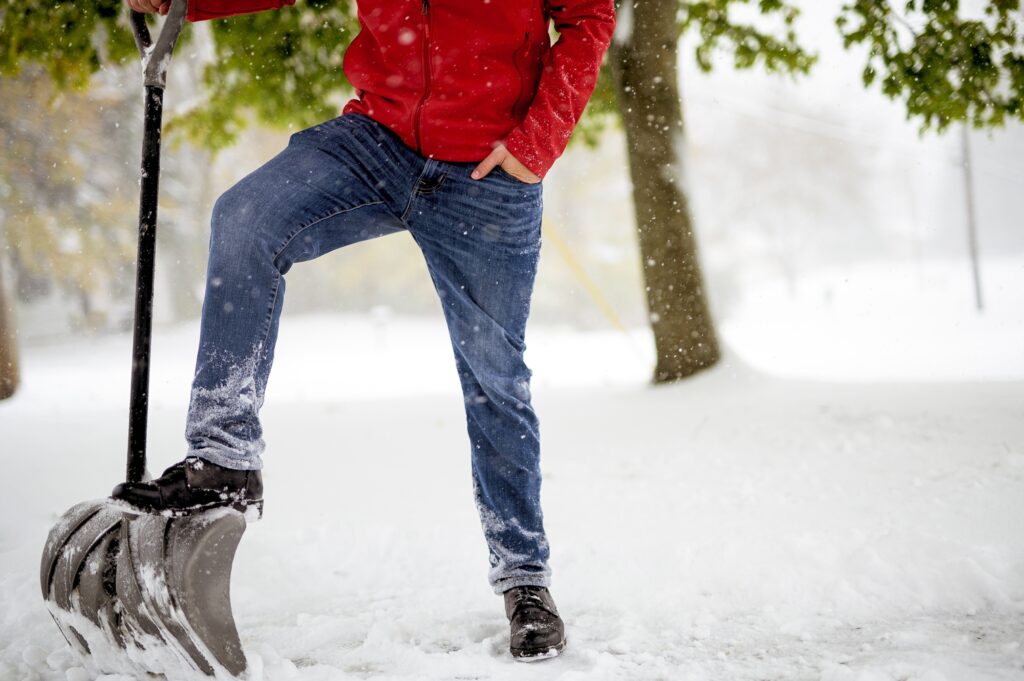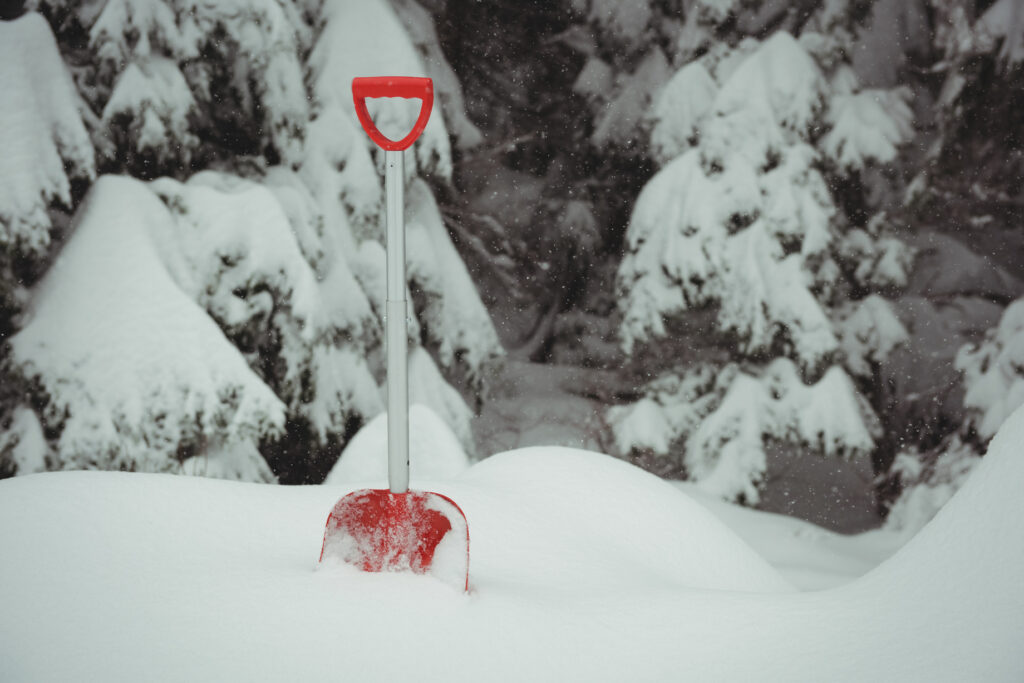Snow shovelling looks simple, but physiologically it is a high-intensity task that can push your cardiovascular and musculoskeletal systems close to their limits, especially in deep, wet accumulations and sub-freezing wind chill. Each scoop may weigh 4.5–7.5 kg, and when repeated rapidly, the total workload can rival moving a small vehicle in a short span of time. Cold air also constricts blood vessels, driving up blood pressure and making the heart work harder precisely when you need it most. This expert guide explains who is at greatest risk, how to recognise warning signs, and the practical steps that reduce danger without compromising winter safety around your home or business. For major storms or heavy, refreezing berms, consider scheduling professional snow removal so you’re not tempted into risky, maximal-effort bouts; outsourcing the worst passes can be the difference between a safe winter routine and a preventable emergency.

Table of contents
- Why snow shovelling can be dangerous
- Who is most at risk during snow shovelling
- Age guidance: when snow shovelling becomes high-risk
- How to shovel more safely if you must
- Tools and alternatives to reduce risk
- Preparation and prevention before a storm
- Preparing your body and heart for the winter season
- Warning signs and what to do in an emergency
Why snow shovelling can be dangerous
How cold weather stresses the heart
Cold exposure narrows peripheral and coronary arteries, which forces the heart to pump against higher resistance and elevates blood pressure during effort. Inhaling icy air also increases afterload and makes breathing shallower, further straining a system that is already working hard. When you combine these factors with repeated lifts and trunk twists, cardiac demand can jump to very high levels within minutes, even in people who feel otherwise healthy. Those with known or silent coronary disease, hypertension, or diabetes are especially vulnerable during the first heavy passes when enthusiasm is high and technique is sloppy. To understand why strong winds amplify danger and perceived cold, see the definition of wind chill, and plan your timing to avoid the worst conditions whenever possible.
Static upper-body exertion vs. dynamic leg work
Shovelling relies heavily on the arms and trunk while the legs remain relatively still, a “static” pattern that causes sharper spikes in heart rate and blood pressure than equivalent leg-driven exercise. Many people unconsciously hold their breath (Valsalva) during lifts, which further elevates pressure and reduces venous return to the heart. Because you are not walking continuously, blood can pool in the lower limbs, reducing oxygenated blood returning to the heart exactly when it is needed. The result is a mismatch between demand and supply that can provoke symptoms, particularly in cold air that tightens airways and vessels. Recognising this unique physiology helps explain why steady walking behind a blower is usually safer than stop-start lifting with a shovel.
Heavy, wet snow and overexertion risks
Wet, dense snow dramatically increases load per scoop, multiplies torque on the spine and shoulders, and accelerates fatigue. As you tire, technique degrades—reaches get longer, twisting becomes abrupt, and breath control worsens—creating a perfect storm for both cardiac and orthopaedic injury. Many people also try to “finish the drive in one go,” shortening rest intervals and pushing past safe exertion thresholds. Instead, plan multiple short bouts with a clear stop rule, and let a professional snow removal crew handle major accumulations or plow berms left by city clears. This balanced approach keeps walkways safe without putting your health on the line when conditions are most punishing.
Who is most at risk during snow shovelling
Hidden heart disease and cardiovascular risk factors
Adults with diagnosed or suspected heart disease, high blood pressure, elevated cholesterol, or diabetes face substantially greater risk during intense cold-weather exertion. Many people harbour subclinical disease and feel fine until a stressor exposes it, so prior normal days do not guarantee safety on the next storm. A family history of early heart disease, previous exertional chest discomfort, or breathlessness that feels “different” are additional red flags. If any of these apply to you, delegate the task early rather than waiting until snow is deep and compacted. Pre-booking professional snow removal for storm days is a prudent prevention plan—not an indulgence.
Musculoskeletal conditions, balance issues, and fall risk
Arthritis, prior back or shoulder injuries, neuropathy, and impaired balance all increase the odds of strains, sprains, and falls on slick surfaces. Reactive slips often trigger twisting loads that the spine and rotator cuff tolerate poorly, especially when carrying a heavy scoop at arm’s length. Appropriate footwear with aggressive tread and traction aids can reduce risk, but cannot eliminate it on black ice or uneven paving. People using sedating medications or recovering from illness should be particularly cautious. When conditions are icy, outsourcing is the safest option for you and your property.
Lifestyle factors: smoking, inactivity, and obesity
Smoking, chronic inactivity, and excess body weight raise baseline cardiovascular strain and impair thermoregulation, making cold work feel harder and less efficient. Deconditioning means you reach high exertion sooner and recover more slowly, increasing the time your heart spends at stressful intensities. If you have been largely inactive, adopt conservative limits—short intervals, lighter scoops, and more rest—rather than “catch-up heroics” after big storms. Supplement manual work with winter supplies such as traction grit and de-icers to reduce the volume you need to shovel. Small, smart adjustments can convert a risky chore into a manageable routine.

Age guidance: when snow shovelling becomes high-risk
Why risk rises after the mid-40s
Population data show shovelling-related cardiac events climb notably after about age 45, when atherosclerotic burden and blood pressure trends typically increase. Ageing also reduces heat production and peripheral vasodilation, making cold stress more potent and recovery slower. While fit, active adults may tolerate brief, light workloads, the margin for error narrows with each decade and with the addition of risk factors. Heavier, wetter snow or low wind-chill should tilt the decision towards avoidance rather than “pushing through.” In uncertain cases, pre-arranged snow removal is the safest default.
Fitness level vs. chronological age: how to judge readiness
Chronological age is an imperfect proxy—recent aerobic training, strength, and mobility are better predictors of tolerance. If you can walk briskly 150+ minutes per week, climb stairs comfortably, and carry groceries without breathlessness, you are better positioned for short, light-duty clearing. Even then, the presence of cardiovascular risk factors should push you toward shorter sessions and lighter scoops. When in doubt, start with a very small test bout and reassess honestly before continuing. Your goal is safe access, not personal records.
Red flags that mean you should not shovel
Do not shovel if you have had recent chest pain, unexplained breathlessness, fainting, palpitations, or a clinician’s restriction following a cardiac or respiratory illness. Active respiratory infections, fever, or poorly controlled blood pressure are also no-go conditions, as is any new exercise intolerance. If you begin shovelling and notice chest pressure, jaw or arm discomfort, unusual dizziness, or an irregular heartbeat—stop immediately and seek urgent care. The driveway can wait; your health cannot. Make advance arrangements so you are not forced into a risky decision under time pressure.
How to shovel more safely if you must
Warm-up, pacing, and work–rest intervals
Perform a 5–10 minute warm-up indoors—brisk marching, dynamic arm swings, and gentle hip hinges—to raise core temperature and prime breathing mechanics. Set a timer for 8–10 minute work blocks followed by equal rest inside to let heart rate and blood pressure settle. During rests, hydrate, recheck how you feel, and decide whether to continue or call it for the day. Treat the driveway like intervals, not a marathon; consistency across several short sessions is safer than one heroic push. For stubborn berms at the curb, call in snow removal to avoid maximal efforts when you are already fatigued.
Push, don’t lift: technique to reduce strain
Use the shovel like a plough: push snow in lanes rather than lifting and tossing whenever possible. When lifting is unavoidable, keep loads small, hinge at the hips, and keep the shovel close to your body to reduce spinal torque. Step the feet to turn rather than twisting through the lower back, and breathe continuously to avoid Valsalva spikes in blood pressure. Smooth, short strokes with deliberate resets are safer and often faster than hasty, heavy scoops. Good technique protects your back and your heart at the same time.
Dress for wind chill: layering, gloves, and breathing through a scarf
Layer a moisture-wicking base, an insulating mid-layer, and a wind-resistant shell to manage sweat and exposure across changing conditions. Wear grippy, insulated boots and thermal gloves that maintain dexterity so you can keep a neutral grip and posture. Cover your mouth and nose with a scarf or buff to warm and humidify inhaled air, dulling the cardiovascular spike from cold breaths. Keep a small cache of essential winter supplies by the door—traction grit, de-icer, spare gloves—so you are never improvising gear in a blizzard. Preparation reduces surprises, and surprises are where injuries happen.
Tools and alternatives to reduce risk
Choosing a snowblower vs. shovel
Snowblowers reduce cardiovascular load by shifting work from lifting to steady walking and guiding, which keeps blood circulating through the legs. Choose the lightest machine that handles your typical snowfall and clear in multiple passes rather than full-depth cuts. Maintain it before the season so you are not wrestling with a stubborn starter in dangerous wind chill. For travel or busy weeks, pre-schedule professional snow removal so coverage is predictable and timely. The best risk reduction is not needing to lift at all.
Lightweight shovels, ergonomic handles, and proper blade size
Select a small-to-medium blade to limit load per scoop and favour a curved shaft or secondary handle to maintain a neutral spine. Lightweight polymer blades shed wet snow better than metal and reduce cumulative strain on the shoulders. Replace cracked handles and dulled edges that snag and force awkward jerks when you are tired. Pair equipment with traction aids and keep a labelled bin of winter supplies near the entry for quick access mid-storm. Smart gear choices make every technique cue easier to execute.
Hiring help and neighbour assistance during big storms
When forecasts call for prolonged, heavy snowfall, line up help in advance so accumulation never outpaces your capacity. Pre-booking a reliable route ensures timely passes and safer walkways for family, customers, and deliveries. Neighbour networks can bridge gaps for light events, while commercial snow removal covers the truly back-breaking ones. Delegation is not defeat; it is disciplined risk management during a high-hazard period. Your winter plan should protect people first and paving second.
Preparation and prevention before a storm
Clearing in passes: shovel early and often
Begin during the storm with light pushes every few centimetres of accumulation rather than facing 15–30 cm at once after it compacts. Early passes reduce mass per scoop, minimise icy bonding to the surface, and shorten total effort time in the cold. Mark driveway edges, stairs, and hazards in autumn so they remain visible under snow and at night. Coordinate with household members so nobody double-handles the heaviest areas while tired. Consistent, staged clearing beats last-minute heroics every time.
De-icers and traction: sand vs. salt
Use sand or grit for traction and chloride blends sparingly to limit concrete and vegetation damage, especially near entryways and landscaping. Pre-treat high-traffic zones before the storm to reduce bonding and speed subsequent clearing. Store de-icers, scoops, and traction mats with your other winter supplies so everything is within arm’s reach when the first flakes fly. Sweep up excess products after the event to protect drains and pets. Good surface management dramatically reduces how much you have to lift later.
Hydration, meal timing, alcohol, and smoking considerations
Hydrate before you start—cold blunts thirst cues, but dehydration elevates cardiovascular strain and cramps. Avoid heavy meals, alcohol, and smoking before and after shovelling, as they raise heart workload and impair thermoregulation and recovery. Caffeine is acceptable in moderation but is not a substitute for pacing and rest. If you feel “off baseline” for any reason—poor sleep, illness onset, unusual fatigue—postpone and delegate. Listening to early signals is a hallmark of safe winter stewardship.

Preparing your body and heart for the winter season
Medical check-ins and medication readiness
If you have heart disease, hypertension, diabetes, or significant risk factors, book a pre-season medical check-in to review symptoms, thresholds, and safe exertion guidance. Confirm that prescriptions (e.g., for blood pressure or angina) are filled and accessible, and discuss whether shovelling is advisable at all this year. Ask specifically about warning signs that apply to you, since presentations can vary, especially with diabetes. Keep a charged phone handy during outdoor work and make sure someone knows you are outside. A few proactive steps can prevent a crisis when conditions are at their worst.
Strength, mobility, and aerobic base
Build a foundation with two to three short strength sessions per week focusing on hips, legs, and core—hip hinges, goblet squats with light weights, and carries mimic shovelling mechanics safely. Add mobility for the thoracic spine and shoulders to reduce twisting strain when you do need to turn. Maintain at least 150 minutes per week of moderate walking or cycling so your circulation and breathing are prepared for cold-weather work. Start this conditioning well before the first snowfall so you are adapting in milder conditions. Fitness is protective, but it complements—not replaces—good judgement.
Cold-weather awareness and hypothermia basics
Learn the early signs of hypothermia—shivering, clumsiness, slurred speech—and set a hard stop rule if any appear. Wet clothing dramatically accelerates heat loss, so change layers promptly if you sweat through or get soaked by sleet. Keep a small indoor staging area with towels and spare gloves so you can swap gear efficiently during rest intervals. Ensure lighting is strong for early morning or evening passes to avoid missteps and slips. Being cold-aware turns a risky chore into a controlled, time-boxed routine.
Warning signs and what to do in an emergency
Symptoms of a cardiac event to watch for
Chest pressure, burning, or tightness; discomfort radiating to the arm, jaw, or back; unusual shortness of breath; light-headedness; palpitations; or sudden, cold sweats all warrant immediate attention. Some people—especially with diabetes—may experience atypical signals such as profound fatigue, nausea, or a sense of dread. Treat any new or escalating sensation seriously, even if it seems mild at first, because cold can mask pain while strain continues. Stop at once, move to a warm place, and reassess with a low threshold for calling help. Waiting to “finish one last strip” is a common and dangerous mistake.
When to stop immediately and call emergency services
Stop at the first sign of concerning symptoms and call emergency services if they persist more than a few minutes or intensify. Do not attempt to drive yourself if you suspect a cardiac event; unlock doors for responders and notify a neighbour if possible. If you have been prescribed emergency medications, follow your clinician’s instructions without delay. Document the time symptoms began to aid responders. Safety takes precedence over a clear driveway every time.
Aftercare: cooling down and monitoring symptoms
After each session, cool down with gentle indoor walking and upper-back mobility to settle heart rate and reduce stiffness in the hours ahead. Rehydrate with water or a warm, non-alcoholic beverage, and change out of damp layers to prevent chill. Monitor how you feel for the rest of the day; delayed chest discomfort, breathlessness, or palpitations should prompt medical advice. Use these signals to adjust future plans—lighter bouts, better tools, or pre-arranged services. The goal is sustainable winter safety, not endurance feats.
Should you shovel snow after 50?
Proceed cautiously and only if you are fit, symptom-free, and the job is light and brief; favour pushing over lifting, schedule frequent rests, and outsource heavy events. If you carry cardiovascular risk factors or have had recent symptoms, arrange professional support in advance. When in doubt, safety comes first and aesthetics can wait. Consider combining limited personal effort with periodic professional snow removal to keep loads small. This hybrid plan balances independence with prudent risk control.
When to stop shovelling?
Stop immediately at any sign of chest discomfort, unusual breathlessness, dizziness, or palpitations, and when technique degrades or wind chill drops sharply. Set a predefined time or effort limit before you start and honour it, even if the driveway is not perfect. If accumulation is outpacing your capacity, call for help rather than pushing harder. Respecting your stop rule is a core safety behaviour. The snow will still be there when assistance arrives.
Who should avoid shovelling snow?
People with known or suspected heart disease, uncontrolled blood pressure, recent cardiac or respiratory symptoms, significant orthopedic issues, or poor balance should not shovel. Those recovering from illness or using sedating medications are also at higher risk. If any of these apply, delegate the task completely rather than attempting “just a little.” Keep winter supplies like de-icer and traction mats handy so pathways remain safe until help arrives. Avoidance is prevention, not neglect.
Is it safe for seniors to shovel snow?
Safety depends on individual health, conditioning, and conditions, but many seniors are better served by brief, light pushing only—or by arranging professional help for storms. Even fit older adults should use strict work–rest intervals, small scoops, and conservative stop rules. If temperatures plunge or snow is wet and heavy, skip it entirely and book snow removal. Preserving health and independence often means choosing the safer path today. A clear path tomorrow is worth the restraint today.
Get in touch with ProZone
If you would like expert guidance, a tailored winter plan, or hands-off service during big storms, our team is here to help. We can combine proactive site checks with timely snow removal so you avoid risky, maximal-effort sessions. Need gear or de-icers today? Explore our curated range of winter supplies to prepare before the next system arrives. For quotes, scheduling, or quick questions, visit our contact page—we’re ready to help you stay safe, efficient, and winter-ready all season.
